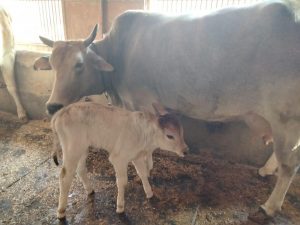Edwin’s Charity in India
Traditional teachers never received salaries or demanded fixed payment, as this would go against the ideal dharma for brāhmaṇas (as in one who knows ‘brahman’) who had to act out of duty and not out of profit motivations for obvious reasons – doing so would taint their relationship with the sacred texts (which are pure benevolent gifts from Īśvara and the sages bestowed upon humanity). But the student also had a dharma which was to give some donation (guru-dakṣiṇā) or service (see e.g. Gītā IV.34 for an expression of this).

Anyway, half of any donations goes to Edwin’s charity in India, which is a huge go-śāla in Vṛndāvana, where Edwin goes to serve the cows every year. Many cows (go) are in an awful condition in India: due to the ahimsā culture towards cows still surviving, they are not usually slaughtered for meat in most parts of the country, but due to the decline in culture, they are no longer cared for as they were in earlier days. And so many of them wander around eating garbage.
There are welfare programs for the desperately poor also surviving on rubbish dumps, and such programs are supremely important, but there are very few programs for the cows. We are making strides to move beyond racism and sexism in our present cultural moment, and so it is perhaps a good time for those of us, especially ahimsā following yogis, with broader para-human sensitivities, to really start pushing against species-ism and adding this to the list of ‘ism’ injustices. The sages of ancient India correlated the spiritual welfare of Vedic India with the way the cows were treated, and so would consider any decline in their treatment with a decline in higher culture and spirituality. While all animal life is respected by those seeking to cultivate the higher qualities of sattva, the cow was seen as especially emblematic of higher qualities due to exemplifying two paramount qualities: para-upakārī and nir-aparādhī.

Para-upakārī, means ‘one who serves others.’ The cow serves humans with all her being – milk; urine for medicine (dung for fuel, which is how rural folks cook); and even bones for glue and skin for leather if she is allowed to die naturally (when I first went to India in the 70s, there was a chain of shoes stores called Ahimsā selling leather shoes from cows which had died naturally). And, similarly, the bull was the mainstay of Indian agriculture prior to the arrival of the tractor – which is another reason why the males are left to wander the streets: they are now redundant and have lost their valuable and indispensable function in society.
 Nir-aparādhī means she offends no one. When unthreatened, the cows are the most loving of creatures. In exchange for simply grass or straw, which is useless for humans, she gives milk and all her gifts. In this way, the sages of India saw the cows as exemplars of these two qualities for human-kind to emulate. And, of course, that Krishna was raised in a fairly lowly forest dwelling cow-herding community, and loved the cows so dearly as expressed in his most popular names – Go-vinda; Go-pāla, Go-pī-nātha – makes the cow all the more beloved by his devotees.
Nir-aparādhī means she offends no one. When unthreatened, the cows are the most loving of creatures. In exchange for simply grass or straw, which is useless for humans, she gives milk and all her gifts. In this way, the sages of India saw the cows as exemplars of these two qualities for human-kind to emulate. And, of course, that Krishna was raised in a fairly lowly forest dwelling cow-herding community, and loved the cows so dearly as expressed in his most popular names – Go-vinda; Go-pāla, Go-pī-nātha – makes the cow all the more beloved by his devotees.